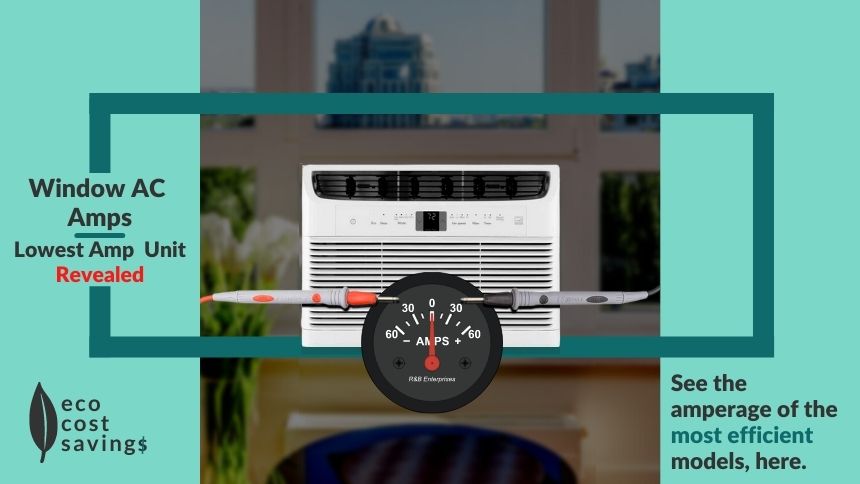Last updated: February 24, 2024.
How many amps does a window air conditioner use? Find out below. Plus, get insights into low amp window AC units, startup amps, & see the amperage of the most energy efficient units in 2024, by room size.
Spoilers:
- The average window AC amperage is 7.82A, while 11A is the most common;
- Overall, window AC amps range from 3.8A to 20A;
- Window AC units experience startup power surges that are typically 2 – 3 times the running amp draw; and
- The lowest amp window AC identified is the 3.8A, 400W, Frigidaire – FFRE053WAE (has a “Low Voltage Start-up” option).
Continue reading to see the amperage of the most energy efficient window ACs, by room size.
Plus, see what amp range is considered low, medium and high.
Note: amperage figures are based on results from two studies – one study focused on the manufacturer listed amperage for 58 of the most popular window ACs on the market (updated for 2024), while the other focused on actual power consumption tests for 1,037 ENERGY STAR certified window AC units (including 2024 models). The relevant study results are referenced within the text.

How many amps does a window air conditioner use?
Window air conditioners use between 3.8A and 20A, with 7.82A being the average and 11A being the most common.
This is based on a study of 58 of the most popular window ACs on the market.
The manufacturer’s listed amperage was used in the study. This is the maximum amperage that the unit is expected to draw under normal operating conditions.
The actual current drawn by the unit is not expected to reach and remain continuously at the manufacturer’s listed amperage.
Window AC amps vary depending on cooling stage, setting, input voltage, along with many other factors.
Cooling stage dramatically increases and even reduces actual current requirements. This is because power hungry components, such as the compressor, cycle on and off during operation.
When these components start up there’s a temporary and considerable spike in power draw (more on this below), which is even higher than the manufacturer’s listed amperage. And when the power hungry components turn off, the draw is considerably lower than the listed amperage.
Settings, such as the desired temperature, and the surrounding area (e.g. next to a heat source) also considerably impact the amount of amps that the window AC actually uses.
The more you make the unit work, the more amps it will draw.
It’s also worth noting that amperage, in general, increases along with cooling capacity (measured in BTU). The greater the window AC cooling capacity, the more amps will be drawn.
However, some units are more energy efficient than others – see the amperage of the most energy efficient window air conditioners below.
Related: How many amps does a portable air conditioner use?
Ultimately, window AC amps listed by manufacturers should be used as a general guide. It’s important to remember that window AC amp draw varies considerably.
The table below summarizes the amperage results from the study of the most popular window ACs on the market.
| Window AC amps category | Amps (A) |
| Average | 7.82A |
| Most common | 11A |
| Highest | 20A |
| Lowest | 3.8A |
The majority, 82.2%, of window ACs draw between 4A and 11A. Just 7.1% of the window ACs studied draw less than 4A, while 10.7% draw more than 11A.
Related: Portable AC Amps, and Wall AC Amps.
As mentioned, these figures are the manufacturer’s listed amperage, which is the max amps their units are expected to draw under normal operating conditions. This does not include startup amps, which are even higher.
Window AC amps at startup
Window AC amps spike at startup. Startup power surges are typically 2 – 3 times the running amp draw.
This is considered a rule of thumb for ACs. Some units draw more, while others draw less.
It’s important for those using off-grid power systems to know and cater to their unit’s startup power surge.
For those using the mains power supply, this is generally not as important. This is because household power circuits, including fuses and breakers, cater to the temporary spikes in amp draw.
Washing machines, dryers, and other household appliances that use motors create significant power surges at startup too.
Window AC amps spike not just when you start it up, but also during various cooling stages. When power hungry condensers, evaporators, and compressors cycle on, amp draw increases dramatically.
The surge is temporary, however, lasting a fraction of a second.
There is a correlation between the manufacturer’s listed amperage and the spike in amp draw. Spikes are somewhat proportional to the manufacturer’s listed amperage.
Typically, a low amp window AC will have a lower spike, compared with their more powerful counterparts.
But one low amp window AC unit stood out from the study. Let’s take a look at this unit next.
Low amp window AC
Low amp window ACs draw less than 4A.
7.1% of the units studied fall into this amp range.
The lowest amp window AC in the study is the 3.8A, 400W, Frigidaire – FFRE053WAE.
This unit stands out for its “Low Voltage Start-up” option, which is of particular interest to those running units off of generators or batteries (e.g. while cooling their RV). The comments and reviews on Amazon are providing some useful insights for these users.
This 5000 BTU, 21.1 CEER, window AC also took the title for the most energy efficient window AC designed for rooms 150 sq. ft. or less.
No other ENERGY STAR certified window AC consumes less electricity than this model.
See the price, features and reviews on Amazon, here.
Related: Window AC vs Portable AC.
For those seeking to cool larger areas, expect the amp draw to increase along with cooling capacity.
This is not always the case, however, as you’ll see next, where we take a look at the amperage of the most energy efficient window air conditioners by room size.
How many amps do the most energy efficient window ACs use?
The table below lists the amperage of the most energy efficient window ACs by room size, based on a study of 1,037 efficient window AC units.
| Room size | Most efficient window AC | Link for more details | Amps (cooling) |
| 150 sq. ft. | Frigidaire – FFRE053WAE | Check it out, here. | 3.8A |
| 250 sq. ft. | LG – LW6019ER | Get details, here. | 4.4A |
| 300 to 350 sq. ft. | Midea – MAW08V1QWT | See its clever design, here. | 8.78A |
| 400 to 450 sq. ft. | GE Profile – AHTR10AC | See the latest price, here. | 11A |
| 500 to 550 sq. ft. | GE Profile – AHTR12AC | Find the price, here. | 11.9A |
| 600 to 650 sq. ft. | LG – LW1517IVSM | Get details, here. | 12A |
| 700 sq. ft. | Keystone – KSTAW15CE | See this product, here. | 11.5A |
| 1000 sq. ft. | LG – LW1817IVSM | Check it out, here. | 8.8A / 7.9A |
| 1200 sq. ft. | No real standout performer | An example unit in this range can be seen, here. | 9.6A |
| 1300 to 1400 sq. ft. | LG – LW2217IVSM | See price, here. | 11.6A / 10.5A |
| 1500 to 1600 sq. ft. | LG – LW2422IVSM | Check it out, here. | 11A / 12A |
| 1800 to 2000 sq. ft. | Friedrich – KCL28A30A | Get details, here. | 13.4A |
| 2250 to 2700 sq. ft. | Friedrich – KCL36A30A and KEL36A35A | Check them out, here and here, respectively. | 18.2A |
For more details on the units above, including their wattage, annual power consumption, and voltage insights, check out: Window AC Wattage [Most Efficient & Lowest Wattage Revealed].
As you can see, while not exactly linear, window AC amps increase along with room size up to 700 sq. ft.
There’s a big drop in amperage after this room size.
This is because, in this list at least, window AC units that cater to rooms 1000 sq. ft. and above require a 208V / 230V supply.
The higher the input voltage, the lower the window AC amp draw.
And, as you can see from the table, the amp draw begins to increase linearly again as the room size increases from 1000 sq. ft.
More amp study results
Window AC amps vary by model, input voltage, efficiency level, cooling stage, and user setting, among many other factors.
I hope that the insights from the studies helped you get a better understanding of window AC amperage.
You might also be interested in getting insights into portable AC amps, and wall AC amps.
You can also get a direct performance comparison, including amperage, between window and portable units here: Window AC Vs Portable AC [Efficiency, Cooling, Noise & More].
-
Quiet Air Conditioner: The Ultimate Study [1,323+ ACs]
See the quietest air conditioner on the market, along with the quietest window, portable and wall ACs. We also reveal the quietest AC type, in this, the most authoritative AC noise level study.
-
Highest SEER Heat Pump Revealed [2,126 Units Studied]
What is a good SEER rating for a heat pump, & what’s the highest? Find out here, based on a comprehensive study of 2,126 of the most energy efficient heat pumps.
-
Quietest Wall AC Revealed [2024 Noise Level Study Results]
Which is the quietest through-the-wall air conditioner? Find out here, based on a comprehensive study. Plus, see the average & most common decibel ratings, and see how loud the most efficient wall ACs are.
James, Eco Cost Savings co-founder and Editor-in-Chief, is also our experienced in-house energy management and sustainability expert, and manager of our network of sustainability consultants.
Before his journey into sustainability, James studied engineering. Additionally, he has experience in HVAC installation, and data analysis. A self-proclaimed practical environmentalist, and avid penny pincher, James established Eco Cost Savings to share his and his colleague’s expertise with the aim of helping to reduce energy bills and carbon footprints at scale.


![Quiet Air Conditioner: The Ultimate Study [1,323+ ACs]](https://ecocostsavings.com/wp-content/uploads/2023/02/quiet-air-conditioner.jpg)
![Highest SEER Heat Pump Revealed [2,126 Units Studied]](https://ecocostsavings.com/wp-content/uploads/2022/10/highest-seer-heat-pump.jpg)
![Quietest Wall AC Revealed [2024 Noise Level Study Results]](https://ecocostsavings.com/wp-content/uploads/2022/08/quietest-wall-ac.jpg)